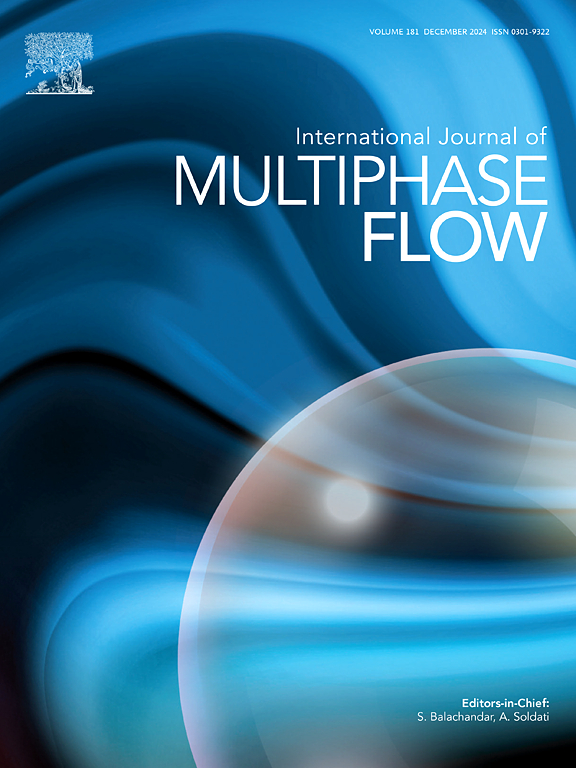Direct numerical simulation of droplet impact onto dry stationary and moving walls at low to high Weber numbers
IF 3.6
2区 工程技术
Q1 MECHANICS
International Journal of Multiphase Flow
Pub Date : 2024-10-11
DOI:10.1016/j.ijmultiphaseflow.2024.105014
引用次数: 0
Abstract
The accurate prediction of the drop–wall impact dynamics and regime are of interest in many engineering applications. Considerable progress has been made in different elements of Direct Numerical Simulation (DNS) approaches. However, identifying the optimal combination of improved submodels that perform well under a wide range of operating conditions, covering low to high Weber numbers with varying surface wettabilities and wall motions, still requires further investigation. Here, we conduct a comparative study on the performance of key DNS elements, including the Interface Tracking (IT) algorithm for the widely-used volume-of-fluid approach, Contact Angle (CA), Contact-Line Velocity (CLV), Instability Actuation (IA), and numerical discretization. The study spans a broad range of Weber numbers, encompassing various impact phenomena such as drop oscillation, partial rebound, fingering, and splash. It is concluded that the Kistler CA model provides the most accurate predictions among the models considered here. In terms of IT, the Multidimensional Universal Limiter with Explicit Solution (MULES) algorithm is the most efficient one, especially for moderate to high Weber numbers. For high Weber numbers, involving the fingering instability and splash events, while applying the IA mechanism slightly improves the results, using a high-quality fine-enough grid and appropriate numerical discretization scheme to control the dispersion and dissipation errors are more important ingredients. It is shown that the recommended model combination is also able to predict the important features of drop impact on moving walls with reasonable accuracy.

在低韦伯数到高韦伯数条件下液滴撞击干燥静止壁和运动壁的直接数值模拟
在许多工程应用中,对落壁式冲击动力学和机制的精确预测都很重要。直接数值模拟(DNS)方法的不同要素已经取得了长足的进步。然而,如何确定改进子模型的最佳组合,使其在从低到高韦伯数、不同表面润湿性和壁面运动的各种操作条件下都能表现良好,仍需要进一步研究。在此,我们对关键 DNS 元素的性能进行了比较研究,包括广泛使用的流体容积方法的界面跟踪 (IT) 算法、接触角 (CA)、接触线速度 (CLV)、不稳定性作用 (IA) 和数值离散化。研究跨越了韦伯数字的广泛范围,涵盖了各种冲击现象,如水滴振荡、部分反弹、指压和飞溅。结论是,在本文所考虑的模型中,Kistler CA 模型的预测结果最为准确。在信息技术方面,具有显式求解的多维通用限幅器(MULES)算法是最有效的算法,特别是对于中高韦伯数。对于涉及指状不稳定性和飞溅事件的高韦伯数,虽然采用 IA 机制能略微改善结果,但使用足够精细的高质量网格和适当的数值离散化方案来控制分散和耗散误差更为重要。结果表明,推荐的模型组合也能以合理的精度预测水滴撞击运动壁面的重要特征。
本文章由计算机程序翻译,如有差异,请以英文原文为准。
求助全文
约1分钟内获得全文
求助全文
来源期刊
CiteScore
7.30
自引率
10.50%
发文量
244
审稿时长
4 months
期刊介绍:
The International Journal of Multiphase Flow publishes analytical, numerical and experimental articles of lasting interest. The scope of the journal includes all aspects of mass, momentum and energy exchange phenomena among different phases such as occur in disperse flows, gas–liquid and liquid–liquid flows, flows in porous media, boiling, granular flows and others.
The journal publishes full papers, brief communications and conference announcements.

 求助内容:
求助内容: 应助结果提醒方式:
应助结果提醒方式:


